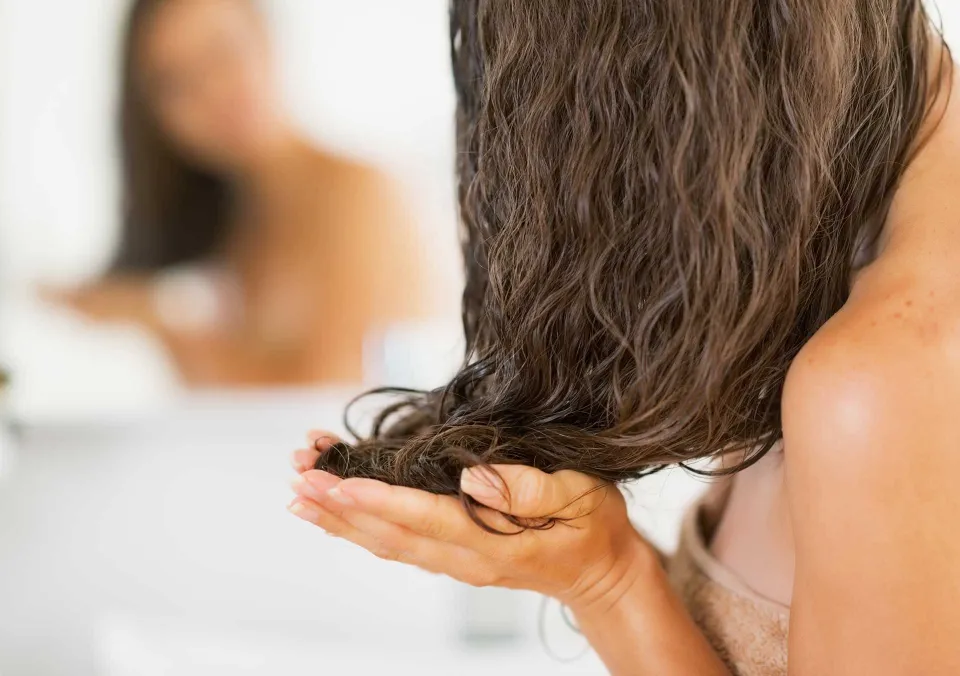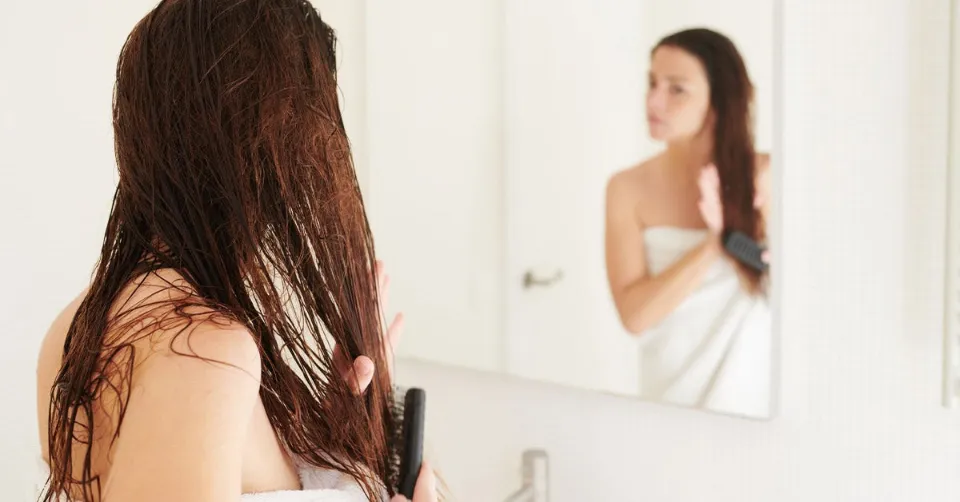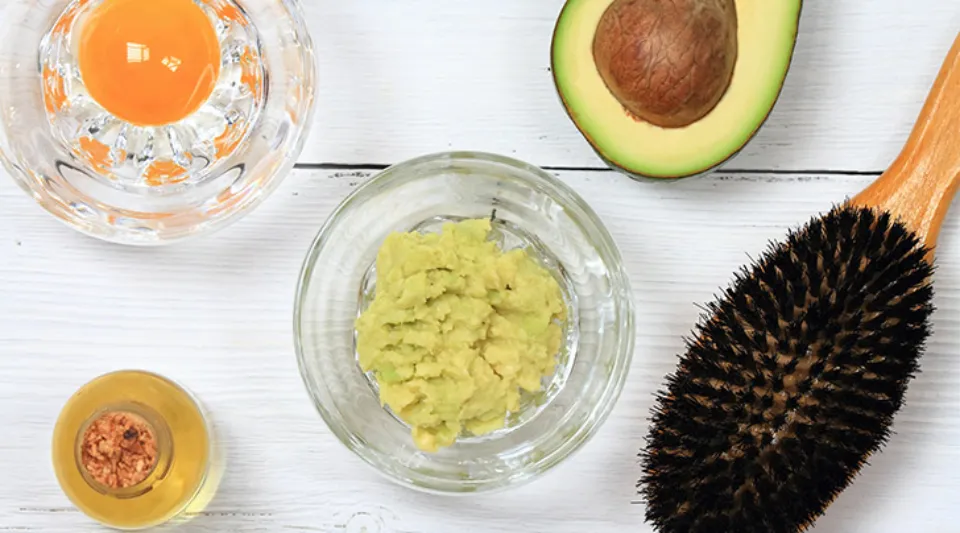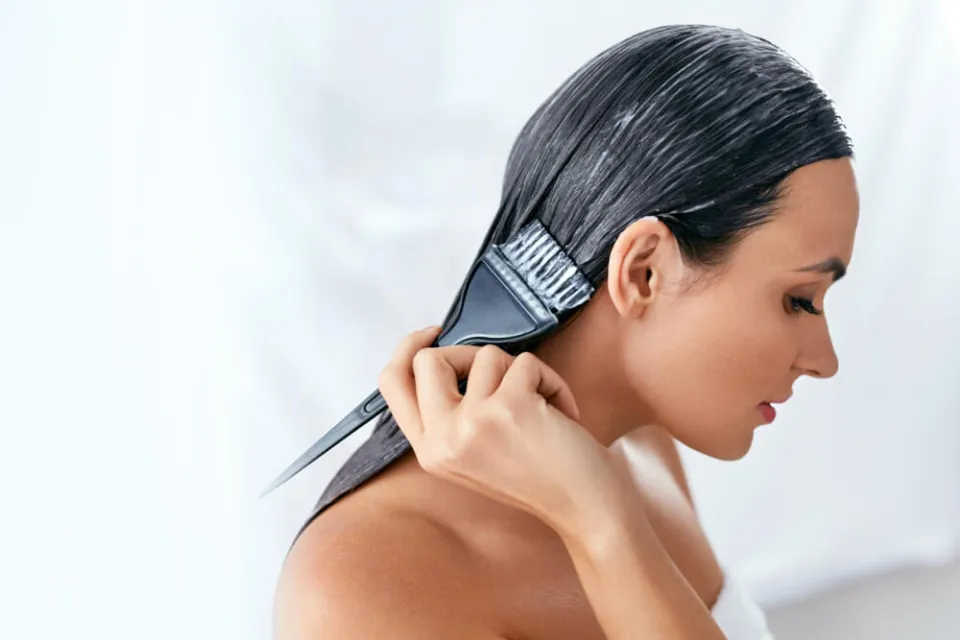The primary objective of hair masks is the same as that of regular conditioners: to deliver moisture and enhance the condition of your strands. The best results can only be obtained by being aware of their proper use and frequency.
Use a hair mask once or twice per week, is the general recommendation. It all depends on various factors, including your hair type and the mask you’re wearing.
Typically, you should replace your regular conditioner with your hair mask once or twice per week. Your hair’s type and current condition will determine the ideal frequency. If they’re dry or damaged, you will likely need this deep-conditioning treatment more often. Less often applications are necessary for healthy or oily hair.
Hair Mask Benefits
During perimenopause, many of us discover our hair becoming thinner, weaker and more easily damaged than before.
When used at the frequency suited for your hair type, masks can significantly improve your hair’s appearance and manageability, counteracting these common concerns and giving you a mane that’s:
- Shinier
- Softer
- Stronger
- Smoother
- Less prone to damage
Also Check: Can You Leave A Hair Mask On Overnight – Expert Suggestions – Home Services Offers
How Often Should You Do a Hair Mask

The frequency of applying a hair mask will undoubtedly depend on your hair type and how frequently you wash it, but as a general rule, you should do so at least once per week. I typically wash my hair 2-3 times a week, so I typically do a hair mask once a week. I might do two if I’m doing something on my ends and something on my scalp.
You are the expert on your hair, so if it is dry or damaged, you should probably apply a hair mask a few times per week. Keep it to once a week if your hair is particularly fine to avoid weighing it down. For best results, be sure to follow the directions. The majority of hair masks need to be applied differently depending on the type of treatment they are, and they typically need to sit on the hair longer than a conditioner. You can use both a hair mask and condition your hair. In general, you wash your hair with shampoo, then use a hair mask, then finish with conditioner. As always, pay attention to the label. I usually only apply hair masks from the bottom of my hair shaft to the ends because I have thick but fine hair (unless the mask is specifically for my scalp).
Another helpful tip I picked up from my hairdresser was to only use shampoo on the roots of your hair for optimum hair health. As you wash it out it will rinse through to your ends, but overdoing it with shampoo can further dry out your hair. Aside from that, avoid using hot water. It’s not good for your scalp or hair (or your skin either).
Can I Use a Deep Conditioner Every Day?
Typical hair masks contain higher concentrations of fatty acids and other hydrating ingredients than typical conditioners.
If a little hydration helps, it stands to reason that more must be better, especially if your hair is dry and brittle. This is not the case, however, with hair masks.
If you deep condition your hair too frequently, you run the risk of over-moisturizing it and disrupting the normal flora of your scalp.
This is due to the fact that your hair can only absorb a certain amount of the additional oils and conditioners in your mask.
After reaching your hair’s maximum saturation point, you may experience a condition called hygral fatigue.
Your follicles constantly expand and contract as a result of the extreme moisture retention, which results in hygral fatigue. If you deep condition your hair too frequently, especially if it has high porosity, you run the risk of developing hygral fatigue.
Symptoms of hygral fatigue include:
- A gummy texture when wet
- Dullness
- Tangling
- Frizziness
Reduce your hair mask usage if your hair starts to feel limp, lifeless, or mushy.
Hair Mask Frequency by Hair Type

Depending on your hair’s need for moisture, you should deep condition it occasionally. Given the number of factors at play, it is best to concentrate on how your hair responds to the hair mask specifically and change the frequency as necessary.
A good rule of thumb is to use your hair mask once a week at first, and then experiment with using it more or less frequently, depending on what works best for your hair type.
Dry Hair
The porous fibers in hair masks act as a sponge to absorb moisture when your hair needs it. Hair masks are made to provide ample hydration. In light of this, it makes sense that if your hair is dry, you will need to deep condition more frequently.
Apply a greater amount of product (usually about a quarter-sized) onto your hair twice a week to start. Use it as often or as little as necessary.
Split Ends and Damaged Hair
The molecular bonds of damaged hair cannot be repaired by hair masks, but they can strengthen your strands to fend off further harm.
Trim the broken segments and split ends first if your hair has been damaged. Use your hydrating mask to deep condition your hair two times a week to begin with.
Frizzy Hair
The cuticle, or surface layer of each hair shaft, is made up of tiny overlapping shingle-like cells. In response to changes in temperature and pH, these cells may open or close.
You’ll have smoother hair that can retain moisture more effectively when your cuticles are sealed shut.
Your hair will look frizzy when the hair cuticle is open. Additionally, they are more susceptible to damage from dryness or humidity when their cuticles are open. To smooth your cuticles and safeguard your cortex, use your hair mask once or twice per week.
Fine Or Oily Hair
Our follicles contract as we age due to dihydrotestosterone (DHT) levels, which results in skinnier strands and thinning hair. Less hair to soak up extra sebum means less hair for some women.
The ultra-hydrating formula of hair masks can overwhelm thin, fine hair if used too frequently. Concentrate your mask application to the very ends of your strands. If you have an oily scalp and hair, keep your mask treatments to once a week or once every other week, using a dime-sized amount.
Curly Hair
More hair mask applications are typically beneficial for your thick, curly hair. Since the spirals in this hair type are numerous, sebum oil has a hard time coating every strand uniformly. This leaves it vulnerable to frizzing and dryness.
You may need to use your hair mask up to twice a week for it to be effective. Your curls will be less likely to frizz, more defined, and more springy.
What Hair Mask Should I Choose?
Better Not Younger provides two different types of hair masks. Both products contain five plant-based butters, including macadamia, murumuru, mango, avocado, and cupuaçu, along with other nourishing ingredients to reduce inflammation brought on by dryness and itching without clogging your pores.
Both masks, like every other item in our Better Not Younger Shop, were specifically created to address the specific hair and scalp issues that come with aging.
- Steep your worn-out hair in our five-butter blend to rebalance and replenish the moisture in your hair and scalp with Hair Redemption Restorative Butter Masque. All hair types respond well to our mask.
- Using the same potent combination of plant-based butters, our Silver Lining mask also contains a purple tint to get rid of any unwanted brassy tones for a flawless silvery shine.
Instead of conditioner after shampooing, use either the Hair Redemption or Silver Lining masque—as often as required for your hair type.
A small amount (about a dime or quarter) should be worked through your hair. For one to three minutes, massage the entire body from root to tip, and then thoroughly rinse with cool water.
When you know how your hair responds to deep conditioning, include our hair mask on a regular basis in your overall hair-care routine.

Conclusion
How often you should use a hair mask depends mainly on 4 things:
- The current condition of your hair (dry, damaged, oily, etc.)
- Your hair texture and type (fine, curly, coily, dense, etc.)
- Your hair’s porosity (low, medium/normal, or high)
- What you want the mask to do (moisturize, strengthen, repair, etc.)
In general, you should use a moisturizing hair mask if your hair is chronically dry, oily, medium or coarse-textured, or damaged in any way. If you don’t want to overhydrate and weigh down strands, use a moisturizing hair mask once every two weeks.
They can be used as often as 3 or more times a week if your hair is coarse or extremely thirsty. If your hair is fine-textured, weak, easily broken, medium to high porosity, or chemically damaged, you should use a protein-based hair mask.








